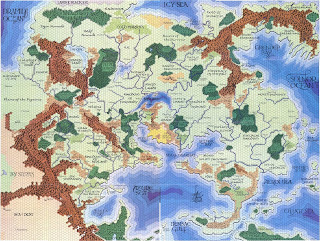 I happen to think that the World of Greyhawk Fantasy Setting is one of the finest fantasy worlds ever conceived. This, I am hopeful, will come as no surprise to anyone reading this blog. But I thought I would explain for a moment as to why I think it is so.
I happen to think that the World of Greyhawk Fantasy Setting is one of the finest fantasy worlds ever conceived. This, I am hopeful, will come as no surprise to anyone reading this blog. But I thought I would explain for a moment as to why I think it is so.
I am tempted to go on at length about the innate genius of Gary Gygax and his boundless creativity, but honestly I think that the published WoG is a far superior product for having been a collaborative effort, even during his heyday at TSR. Don’t forget that the original Lake Geneva campaign bore little resemblance to the Greyhawk published in the 1980 Folio, or 1983 gold box. What was published wasn’t the original campaign, but– quite remarkably– we are told that the players in that original campaign actually lobbied for Gary’s campaign to be altered to conform to the published version!
Inasmuch as any campaign is a collaboration between the DM and the players, so too was Greyhawk. Without the players there would be no Robilar, no Melf, etc. People other than Gary Gygax wrote some of the most influential modules that ended up becoming institutions of Greyhawk; the Slave Lords series, Mordenkainen’s Fantasic Adventure, The Hidden Shrine of Tamoachan, the Lendore Isle series, etc. etc. etc. Gygax was not the author, but they made their indelible mark upon the setting.
I also think that a mark of an outstanding setting is its ability to step beyond the game system for which it was originally designed. Greyhawk stands out in this regard as possibly the most transported game setting in history. There are campaigns in Greyhawk using the various A/D&D rules and their clones, of course, but there are also ones using the rules for Castles and Crusades, Savage Worlds, GURPS, Rolemaster, Fantasy Hero, Hackmaster (“Greyhack”), and doubtless others I am unaware of. I personally think Greyhawk, with its very feudal setting, would be perfect for adaptation in the Chivalry & Sorcery game, and I might just do it myself, if I can ever get a set of the first edition books at a reasonable price. My point is, most settings are dependent on a single game system; Dark Sun, Gloranthia, etc. Greyhawk persists outside of a particular game system, meaning that the setting itself has qualities which give it merit.
The fact that it is, as I alluded to above, largely an amalgam of Medieval Europe and its feudal system is, I think, a plus. It’s easy to extrapolate from what is fairly well understood. Too many settings go out of their way to be DIFFERENT!!! and end up just being quirky. I think that’s why Jorune never caught on, despite the absolutely gorgeous art that the game enjoyed; what the heck is a thriddle? But you say “There is a troop of the Overking’s Lancers in full plate trotting down the forest road” and you can much more easily paint the picture.
Perhaps the best quality Greyhawk had, in terms of accessibility and endurance, is that it wasn’t exhaustively detailed. I really like the Forgotten Realms, but it was just too easy to get overwhelmed by the sheer amount of detail. The history, the characters, the politics; as a DM I felt like I was boxed in, unable to go off on some tangent for fear that I would contradict something that had already been published. With Greyhawk, there is the skeleton, and points of punctuated elaboration (in the form of adventure modules and, later, kingdom books like Iuz the Evil). Entire kingdoms are described in two paragraphs; that gives me the latitude I like when I’m running a game. Harn was downright intimidating with its level of detail, even moreso than Forgotten Realms because it was on such a small scale!
So, to sum up, I think Greyhawk’s enduring popularity comes down to:
- A strong editorial hand, but not to the point of exclusivity
- Trans-game endurance and portability; the strengths of the setting transcend the rules
- Familiar enough to help establish setting, with not so much detail as to need an M.A. in Medieval Studies to play.
- A skeleton framework to build on, not an already-built edifice to play within.
This, of course, doesn’t attempt to define “what makes Greyhawk”; militant neutrality, NPCs, etc. But in a general sense, I think it does help to see why Greyhawk has endured all these years, and why it’s likely to in the future, regardless of where the rules end up.









I never caught on to Greyhawk because to me, it was always the "generic D&D campaign". Why use an official campaign you might have issues with when you can steal anything from it for your custom-made world? I guess this falls under the "isn't exhaustively detailed" advantage you discussed, the same reason I preferred Greyhawk over FR before 4th edition. (I'm holding off judgement on 4th-ed. FR for now.)
But my favorite "generic D&D campaign setting"? Mystara. Plenty of the advantages Greyhawk has, plus a damn big hook (there's another surface on the inside where primitive civilizations/beasts still thrive) for expanding the campaign. My love of pulp stories & dinosaurs might have something to do with it. (I'm an Eberron fan as well.)
I just started using Greyhawk again in my current campaign. I agree that with the Greyhawk setting there is room enough to make the world your own. The structure is there for those of us who don’t have the time or inclination to create an entire world of our own. I guess it helps that I just found my old 1e Greyhawk Adventures book.